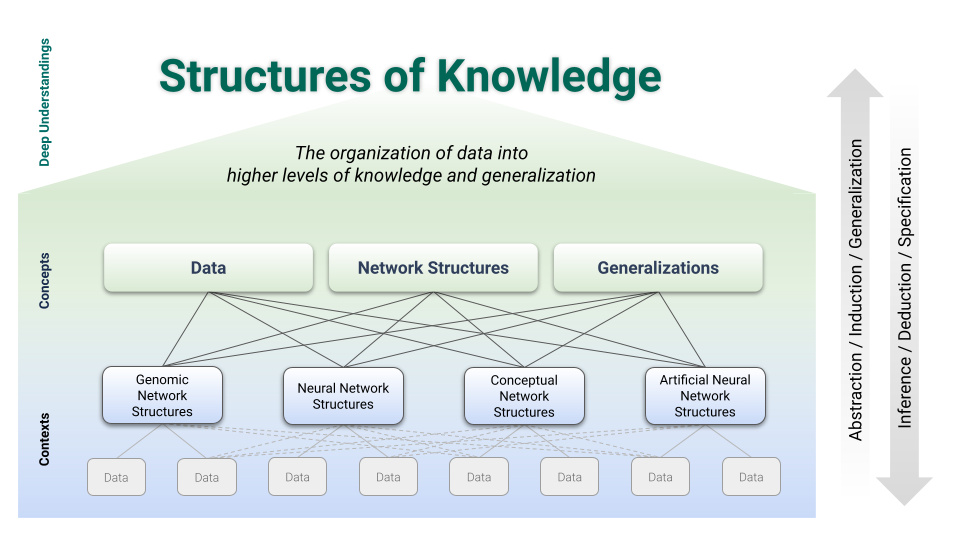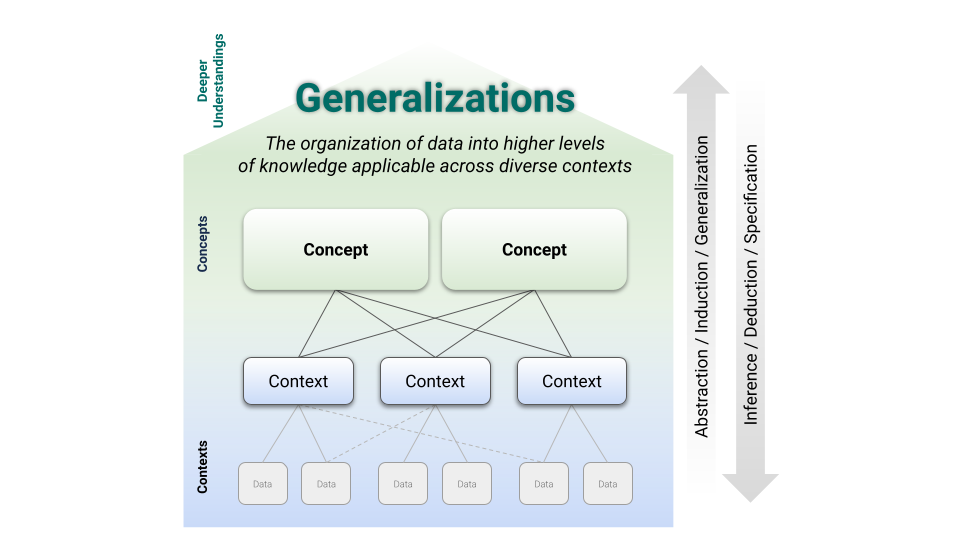Structure of Knowledge Diagrams
Simple graphical representations that relate specific knowledge to generalizations and theories can help us understand the structures of knowledge around the world and within each of us as individuals and communities.
Structure of Knowledge (SoK) Diagrams, like the one to the left here, provide a model for the organization of information and understanding across a wide diversity of domains. This page is a growing resource for using SoK diagrams in the classroom, aimed at students, teachers, and other community scientists seeking to understand, map, and explore the diverse structures of knowledge that shape our everyday lives and global society.
Use the options below to learn more about how you can productively use SoK diagrams in your own learning and research.
Or, learn more about Structures of Knowledge as related to school curriculum design and improvement.
Learning the basics of how to read an SoK diagram is your first step to understanding how knowledge is organized in our world.
SoK diagrams are meant to be developed, discussed, and revised by the people they are relevant to. Learn how to draft your own here.
Anyone interested in science, education, and society can contribute to applied educational design research through the critical analysis of SoK diagrams.
Reading SoK Diagrams
The central aim and requirement for any SoK diagram is to communicate the relationships between abstract concepts and domains of application.
This could include everyday examples (e.g. the human concept of „pets“ may or may not apply to different animals in different cultural contexts). It can also include scientific examples – as when scientists debate the merit of evolutionary concepts across biological, cultural, and computational contexts.
The basic model of SoK diagrams we advance here, is adapted from the work of educator H. Lynn Erickson (2017) and her colleagues (see also Stern et al. 2021). In this approach, higher-level abstractions or generalizations are placed towards the top of the page, with domains of application, and „data“ or „facts“, organized towards the bottom. These „nodes“ are „linked“, in ways that may be obvious, or may require further reflection, discussion, or explanation.
This is a general rule of thumb, and different authors may adopt or invent unique norms of communication. It is therefore important to keep in mind that:
- All SoK diagrams are provisional and incomplete. It is not practically possible to draw or model a „perfect“ or „complete“ SoK.
- The specific Theories, Generalizations, Concepts, and even Contexts of a given SoK diagram can often be understood at other levels of analysis. That is, a context could also serve as a concept or even a generalization, depending on the focus of the analysis.
Drafting SoK Diagrams
The examples of SoK diagrams on OpenEvo are just a starting point for discussion.
How is knowledge about the world you live in structured?
Some basic guidelines for developing your own models include:
- Identify the core domains or contexts you are interested in understanding. This could be a subject area (e.g. „Biology“); a global or regional issue (e.g. „school improvement“); or any other topic or aspect of the world which can be understood in terms of concepts. Add these domain contexts towards the bottom of your page.
- Ask yourself and others: „What concepts live here?“. What concepts do „we“ or „others“ use to understand the domains of interest? Add these concepts towards the top of your page, exploring possible ways in which some concepts may help structure, organize, or contextualize others.
- Reflect on how these concepts are related to each other, and to the (various) domain contexts below. Draw (and optionally, label) lines between related concepts and domains.
Check out this short video on the work of H. Lynn Erickson as one approach to thinking about Structures of Knowledge.
Studying SoK Diagrams
How can we more systematically document and compare SoK models from across cultures and contexts around the world?
This is a question of high importance for educational innovation and school improvement, as school curricula are fundamentally cultural representations of collective beliefs about SoK in the world at large.
If you are interested in developing applied research in the area of SoK diagrams for science education and school improvement, contact Dustin Eirdosh to discuss further.
References
Erickson, H. L., Lanning, L. A., & French, R. (2017). Concept-based curriculum and instruction for the thinking classroom. Corwin Press.
Stern, J., Ferraro, K., Duncan, K., & Aleo, T. (2021). Learning That Transfers: Designing Curriculum for a Changing World. Corwin Press.



